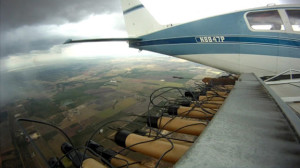
Cloud seeders in Pleasanton, Texas, artificially prime thunderstorms to deliver extra rain. Photo by Juju Chang. (abcnews.go.com)
On March 15, 2014 the City of Wichita Falls, Texas, began a cloud seeding operation in a desperate attempt to increase rainfall in the drought stricken north Texas city. Since 2011, the city has suffered drastically from heat and lack of rainfall. Limitations on water use in the region and generally, throughout the state of Texas, have become more stringent as the drought worsens. But unlike earlier droughts that were more harmful to agricultural elements of the state, the latest drought has turned the focus from pastures to reservoirs. (1.)
As early as 1874, there was speculation that artillery fire in large battles at Waterloo, Buena Vista during the Mexican War, and during or shortly after significant battles of the Civil War caused heavy rains to fall. By 1880 General Daniel Ruggles obtained a patent for producing rain by concussion. In the following decade the concept was tried out in Texas during the Drought of 1891-1894. (2.)
A series of experiments were conducted at four locations led by General Robert St. George Dyreforth. During 1891 the primitive experiments began at Midland, followed by one at El Paso, and another at the King Ranch at the invitation of Robert J. Kleberg. The King Ranch attempt was the most successful but scientists remained skeptical. Later the next year, an unsuccessful attempt at rainmaking at Camp Farwell near San Antonio, led University of Texas physicist Robert MacFarlane to declare both the experiment and theory faulty. Between 1910 and 1914 when addition experiments in Garza and Lynn counties failed to produce rainfall, the concept of weather modification due to the concussion theory was abandoned in Texas. (3.)
By 1946 Vincent Schaefer, scientist at General Electric Laboratories in New York, proved that dry ice could produce ice crystals in certain clouds. Even though it was already known that ice crystals could increase precipitation, Schaefer’s discovery provided another option for weather modification. Bernard Vonnegut subsequently found that silver iodide, a substance very similar to dry ice, could also produce ice crystals. These two discoveries led to modern attempts at cloud seeding with both dry ice and silver iodide. West Texas Utilities and the City of Dallas contracted with Irving P. Krick, pioneer in operational rainmaking activities using the new discoveries, to produce rainfall and break the difficult drought of the 1950s. Krick used ground-based silver iodide generators to introduce crystals into the atmosphere. Although the results were less than favorable, they represent the beginning of modern weather modification in Texas. Within a few years aircraft were used to place the seeding agent in the cloud at the appropriate time and place. (4.)
Cloud seeding projects use specially-equipped aircraft designed to place seeding materials in the form of pyrotechnic devices, or flares, containing silver iodide and other compounds into the convective towers, or turrets of growing thunderstorms, to induce them to expand and process more atmospheric water. Burning flares or ejecting the materials from the underside of the aircraft achieves the seeding. (5.)
The number of commercial weather-modification projects in Texas increased rapidly in the 1950s and 1960s prompting the state to adopt a statue controlling cloud-seeding operations. The Texas Weather Modification Act of 1967 charged the Texas Water Development Board to license and permit weather modification in the state and to promote research and development in its technology. Four projects developed out of the legislation. Three, in San Antonio, San Angelo, and Corpus Christi, were later cancelled. The Colorado River Municipal Water District Program in Big Spring has increased precipitation in its target areas. (6.)
Results from the Big Spring program indicated that a potential for rainfall increases from seeding is substantial in West Texas. With the current demands to replenish fresh-water supplies in aquifers and reservoirs and meet the needs of agriculture, industry and municipalities for fresh water, cloud seeding appears to be one strong element in the long-term water-management strategy for Texas and the arid Southwest.
- Betty Blaney, “Wichita Falls awaits word on wastewater use,” Dallas Morning News, 14 April 2014, 3A.
- John C. Rayburn, “Cannonading the Clouds at Midland, 1891,” West Texas Historical Year Book, Vol. XXXIV, October 1958. (Abilene: West Texas Historical Association, 1958), 50.
- Donald R. Haragan, “WEATHER MODIFICATION,” Handbook of Texas Online (http://www.tshaonline.org/handbook/online/articles/ymwed), accessed May 8, 2014. Uploaded on June 15, 2010. Published by the Texas State Historical Association.
- “WEATHER MODIFICATION.”
- “Harvesting the Texas Skies in 2011 – A summary of Rain Enhancement (Cloud Seeding) Operations in Texas,” www.tdlr.Texas.gov/weather/summary.htm. Accessed May 8, 2014, 10:43 AM.
- “WEATHER MODIFICATION.”
